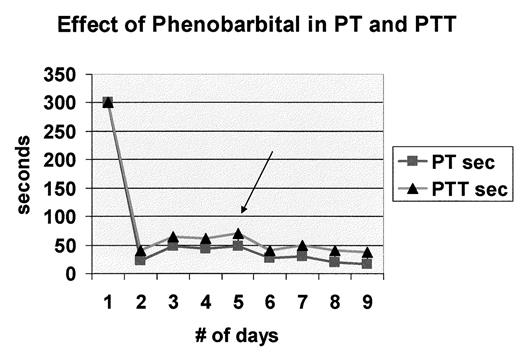Abstract
Background: “Superwarfarin” was developed in the 1970s as an anticoagulant rodenticide. The half-life of the “superwarfarin”, brodifacoum, is four times longer than warfarin. Patients with significant brodifacoum ingestions have often required long-term treatment with vitamin K1 (e.g., 6 months), occasionally with adjunctive phenobarbital therapy.
Case: A 52-year-old male was admitted to the hospital after being found unconscious at home. He was pale and tachycardic at presentation with an oozing laceration on his right leg and bright red blood per rectum. Two liters of maroon fluid were recovered via nasogastric lavage. Admission laboratory values included: PT > 300 seconds, aPTT > 300 seconds, hemoglobin 2.8 g/dL, hematocrit 8.8%, and platelet count 400,000 per μL. Metabolic acidosis with an increased anion gap was present. A drug screen (Toxi-Lab®) was negative. Alcohol, salicylate, and acetaminophen assays yielded negative results. The following day, the patient admitted ingesting with a total of 170 grams of brodifacoum with suicidal intent. Subcutaneous vitamin K1 (10 mg QID), octreotide acetate (50 mg PO), and pantoprazole sodium (40 mg PO) were administered. He improved clinically, but his PT (range: 22.4–47.4 seconds), INR (range: 2.1–5.5), and aPTT (range: 40–70 seconds) remained abnormal. On hospital day 5 his vitamin K1 dose was increased to 25 mg QID and oral phenobarbital (30 mg TID) was started. A total of thirty-eight units of plasma and 8 red cell units were transfused during the admission. He was transferred to an inpatient psychiatric facility on day 8, and he was discharged from that facility after 5 days. Vitamin K1 and phenobarbital were discontinued at this time. Three and one-half months later, the patient was asymptomatic. His laboratory values included: PT 13.2 seconds, INR 1.1, aPTT 25 seconds, hemoglobin 14.3 g/dL, and hematocrit 42%. A serum brodifacoum level yielded negative results.
Conclusion: Superwarfarin has been noted to be an increasingly common cause of poisoning in the past 20 years, especially in intentional ingestions. Many cases have been successfully treated with long-term vitamin K1 — with adjunctive phenobarbital given to some patients. The rationale for using phenobarbital in this setting is that it increases warfarin metabolism by inducing cytochrome P450 isozymes known to be major catabolic enzymes for warfarin (CYP2C9/19) in the liver. We report the successful treatment of significant brodifacoum toxicity with a short course of vitamin K1 (13 days) in combination with phenobarbital (6 days).
Author notes
Corresponding author


This feature is available to Subscribers Only
Sign In or Create an Account Close Modal